#omnidirectional speakers
Text
Omnidirectional build Mk0
I got hold of a cheap little driver in London for £15. It's rated for 200W peak power, 40Hz-10kHz (so sadly not much high frequency once the lamellae are attached!) I removed the rubber sleever and the dust-cap
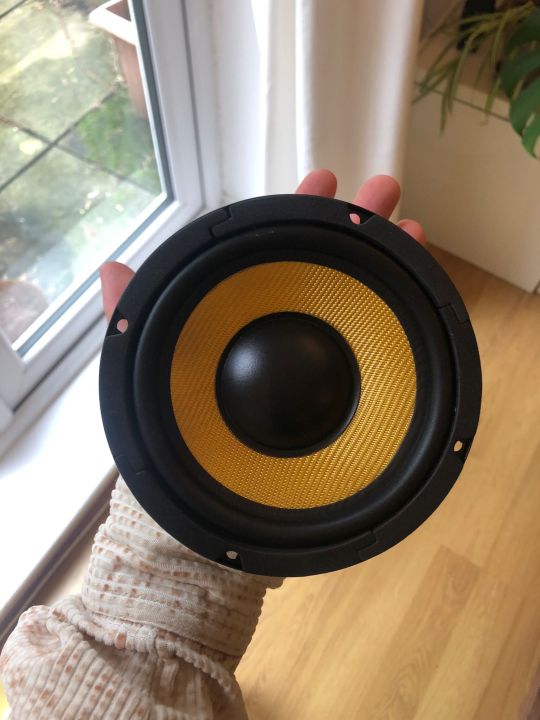

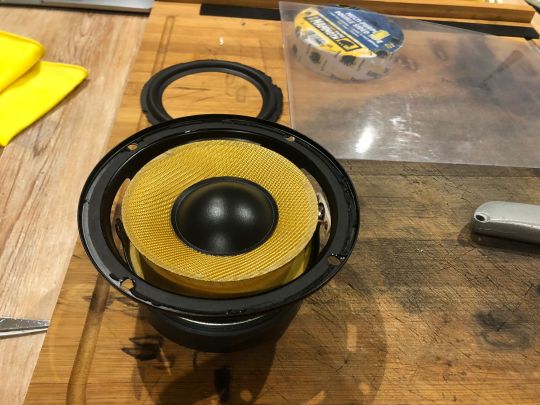

Next I used some grocery-store plastic sheeting (what they put up promotion signs/prices with) that can be moulded using hot water. I used a metal grille bent into a curve to make curves out of the plastic, then cut them into roughly the right shape. I made the paper shape guide by just rotation a ruler held at one end - this was totally eyeballed and could've been done much better, more precisely etc.


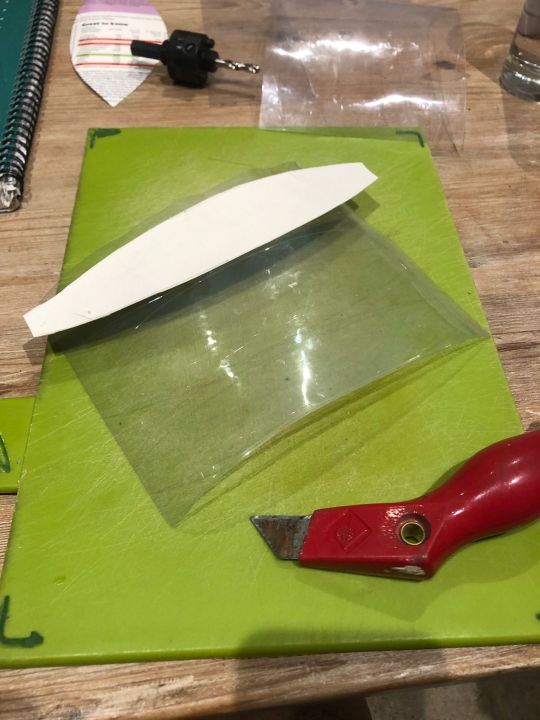

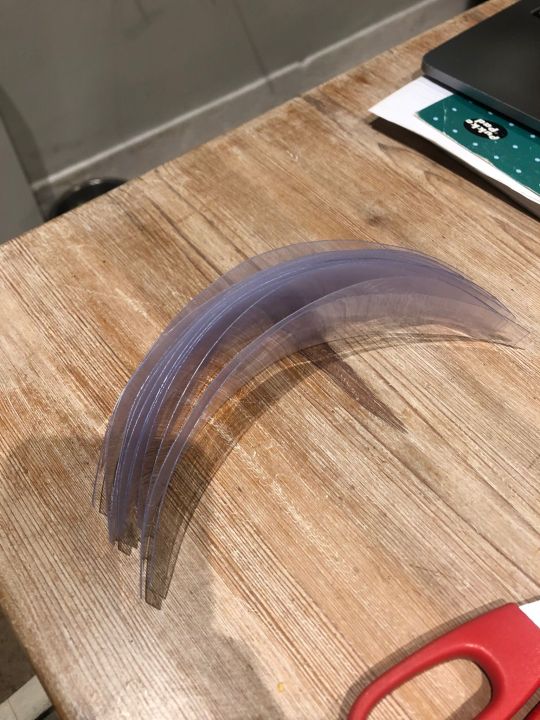
Then I attached some sticky-backed weather stripping to each of the lamellae (aka petals), and used double-sided tape to stick them onto the speaker cone. I used a log with a notch cut into it, attached through the speaker magnet's central hole with a long screw, to hold the tops of the lamellae.

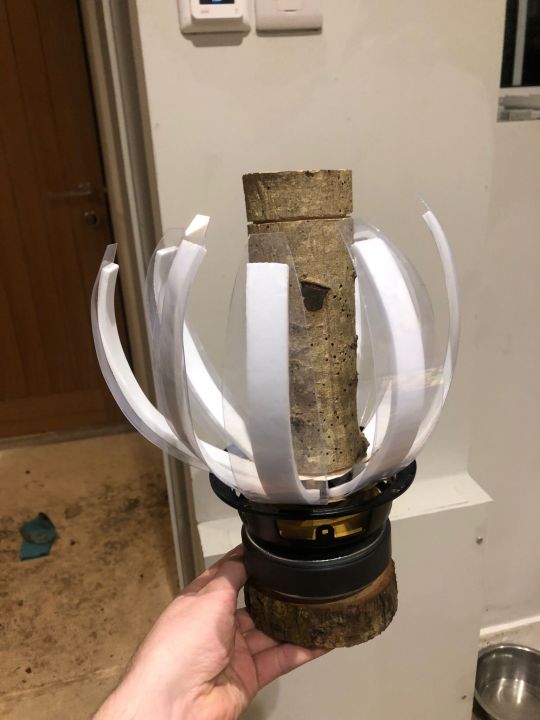
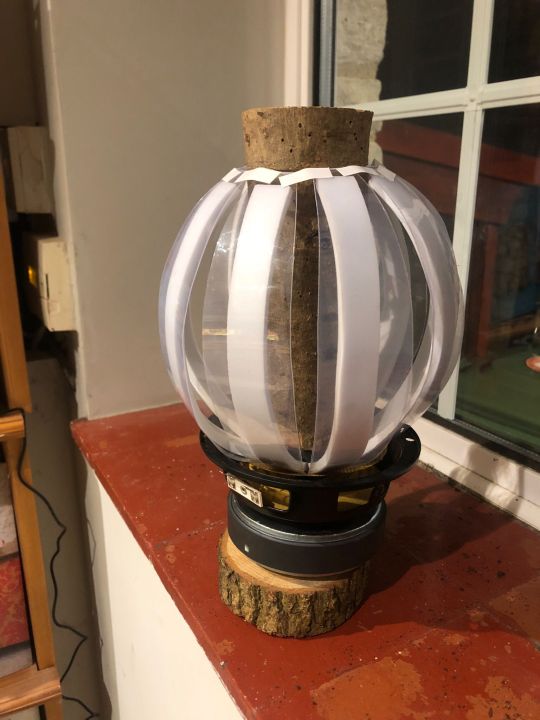
Then with a bit of wiggling and more double-sidede tape I attached all the lamellae together at the top. I used some washing up gloves cut into strips as (very makeshift) gaskets to mostly seal the gaps between the lamellae. Again, I used double sided tape to do this. To be honest that was the most fiddly part. Washing up gloves cut with scissors are not an ideal Radialstrahler gasket material!

And there it is! It doesn't sound terrible on its own, but as the driver is only rated up to 10kHz (and who knows what impact the radialstrahler build has on the theoretical frequency response!) I had to wire it in to an old bookshelf speaker's tweeter to get a bit more high-end.
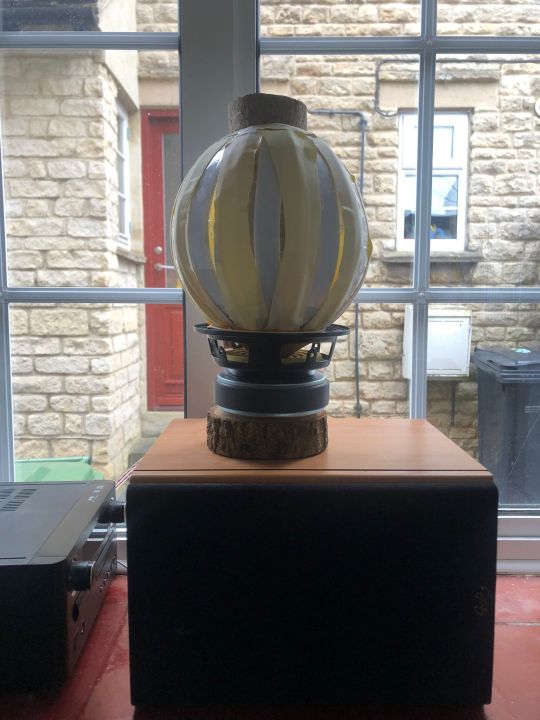
I'll make another post with a few more videos of it playing, along with some discussion of what I've learned so far to take forward to the next prototype!
#sound system#reggae#dub#preamp#amplifier#jah shaka#Steppas#UK dub#UK Steppas#omnidirectional#omnidirectional speakers#Experimental audio#DIY audio#DIY speakers#MBL Radialstrahlers#Duevel#Hifi#Stereo#Audio engineering#acoustics#Totem Pole#Speaker Design#DIY Speaker#MBL Xtreme#MBL 101#MBL#Channel one Sound System#Jah Shaka Sound System#Aba Shanti#Aba Shanti Sound System
2 notes
·
View notes
Text
Omnidirectional Speakers in Outdoor Environments Spreading the Sound
In the realm of audio technology, the demand for immersive outdoor sound experiences has led to the evolution of innovative solutions. Among these, omnidirectional speakers stand out as a game-changer, redefining how we spread sound in open spaces. As we explore the realm of outdoor acoustics, it's evident that PA speakers play a crucial role, especially in environments where clarity and reach matter most.
At OWI Inc. (www.owi-inc.com), a pioneer in cutting-edge audio solutions, the integration of omnidirectional speakers into outdoor environments takes center stage. These speakers boast a unique design that radiates sound uniformly in all directions, ensuring an expansive and enveloping auditory experience for listeners.
Omnidirectional speakers, meticulously engineered by OWI Inc., transcend the limitations of traditional audio setups. Their ability to disperse sound evenly across wide areas makes them ideal for outdoor events, parks, stadiums, and more. With OWI's commitment to quality, these speakers deliver crisp, clear audio that captivates audiences without compromise.
Imagine a scenario where a live event is in full swing in an open arena. OWI's omnidirectional speakers strategically positioned throughout the space ensure that every note, every word, reaches the ears of the audience with unparalleled fidelity. This immersive experience is made possible by the careful design and superior craftsmanship that OWI brings to its range of audio solutions.
As a leading provider of PA speakers, OWI Inc. understands the significance of avoiding keyword stuffing. This blog emphasizes the value of omnidirectional speakers in outdoor environments without compromising on the informative content readers seek. By maintaining a low keyword density, we aim to deliver an engaging and insightful piece that aligns with OWI Inc.'s commitment to excellence.
In conclusion, the integration of omnidirectional speakers from OWI Inc. elevates outdoor audio experiences to new heights. Whether it's a public gathering, sporting event, or entertainment spectacle, these speakers ensure that the magic of sound is spread seamlessly, creating memories that resonate. Explore OWI Inc.'s offerings to discover how cutting-edge audio technology can redefine your outdoor auditory landscape.
0 notes
Text
In the world of audio technology, the advancement of speakers has led to varied and sophisticated designs to enhance sound quality. Among these, omnidirectional speakers have gained significant attention due to their unique ability to radiate sound uniformly in every direction. Here’s a deep dive into the essence and advantages of these revolutionary speakers.
0 notes
Note
I saw ur Sunny and I raise you
Moonie? 🧸🌜
Exactly the same feelings as Sun: of course Moon is a caregiver, but I also think it would be so fun to write him as a regressor.
Like many of the other fnaf animatronics, Moon's non-corrupted personality is largely a biased extrapolation, so I'm sorry if my headcanons don't match other people's but that's the point of headcanons, I suppose!
Three Four Headcanons:
1- Moon's programming is mostly around naptime, but that doesn't mean he doesn't have protocols for leading up to naps, as well as activities to keep children quiet if they really can't sleep: he can sit and colour with you, he can play quiet songs: he has speakers in his palms so he can act like some little headphones for a single person if he's not using the omnidirectional ones
2- Of course he's also a very good bedtime storyteller: some of them are preprogrammed and others are improvise, but all of them share a meditative theme of journeys and changing scenery, designed to guide you into peaceful dreams
3- If you want to learn a new language, Moon is also very good at telling simple stories in basically every language, so he's a good resource!
4- Just like Sun, if you're recognized as a regressor, Moon will also pick you up and try and get you down for naptime at regular intervals: their system is not the best at recognizing the in-between nuance of 'sometimes child, sometimes adult'
send me a 🧸 and a character and I’ll give you three random agere headcanons I’m catching up now! <3
#fnaf agere#agere headcanons#fandom agere#asks#anon#headcanon ask game#my headcanons#horror source#fnaf
36 notes
·
View notes
Text
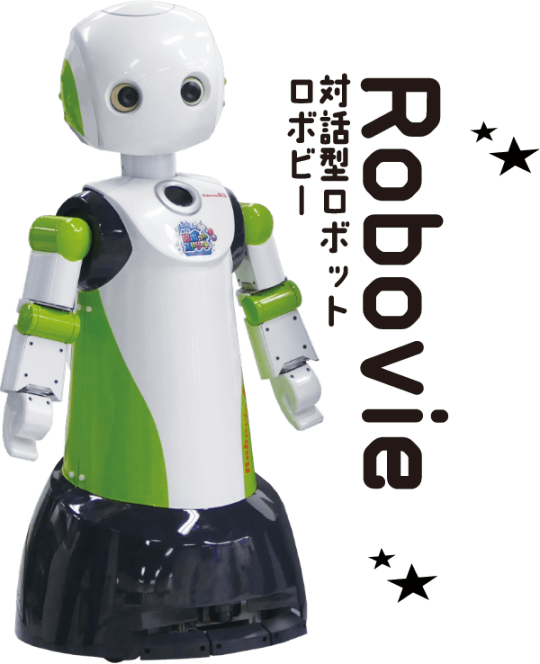





youtube
Robovie-R3 (AKA Robovie R Ver. 3) by Ishiguro Hiroshi, Vstone, Japan (2010). Robovie R3 is a humanoid healthcare and guide robot, designed to give assistance to the elderly and disabled in public places. It has an omniwheel base able to traverse wheelchair ramps, and raised tiles that provide guidance for visually impaired people.
"Robovie R3 is built of plastic over an aluminum frame. It stands about 108cm (3′6″) tall and weighs 35kg (77 pounds). It is equipped with 15 servomotors which enable it to perform 13 degrees of freedom (neck x3, 2 arms x4, 2 omnidirectional wheels) with bonus 4 degrees of freedom from its eyes. It has 11 tactile sensors throughout its body. Robovie R3 is equipped with 2 USB cameras for eyes, 2 mono microphones for ears, a speaker for a mouth, and can be equipped with a laser range finder in its base for obstacle detection." – Robovie R3 robot is much better yet cheaper than previous version." – Robovie R3 robot is much better yet cheaper than previous version, Robaid.
4 notes
·
View notes
Text
12.26. Studio
Curtains of leathery tissue seal this area. Inside, a rudimentary film studio has been set up. On the east side of the room, a holo-projector, capable of creating life-like scenes and figures. Audio is supplied by a set of omnidirectional speakers.
When the adventure party enters the room, a broadcast is in progress. An address from a holographic rendition of the Tetric Necromancer, demanding that the intruders be captured immediately!

3 notes
·
View notes
Text
Location Sound 101 - with Derek Livesey
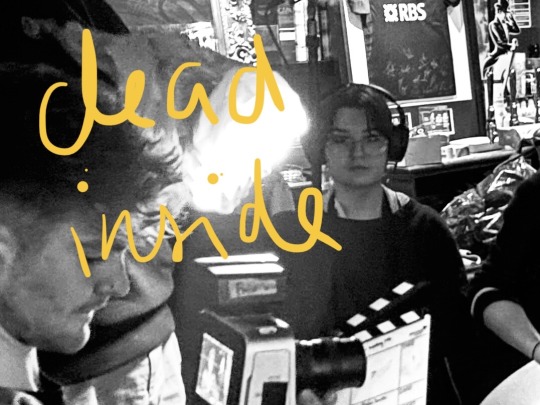
Higher frequencies are more directional
When walking and booming could try booming towards the sky but usually you want to be directing it at the floor
Usually want the driest, crispest sound- unless the shot informs otherwise
Sound wave -> diaphragm -> converts magnetism to voltage -> amplified
Condenser mics inc. shotgun mics
Polar patterns:
Omnidirectional e.g radio mics, used in television, theatre as well
Cardioid
Figure of Eight e.g for two way conversation in radio, orchestra coverage
Shotgun
Camera ops listen, sound recordists watch - basically keep watching to anticipate when you need to move the boom to favour the next speaker.
Room tone should always be mono because dialogue is mono / Atmos is a choice
Keep notes!! (dope sheet/sound report) Rough notes on set, write up later that day
Get your kit sorted before you get on set
Get loads of tape (red, gaffer, masking, artists etc - good for marking radio mics etc)
Sample rate - like snapshots, as frames per second is for camera, aliasing is what happens when they don’t quite match up, we use 48kHz because the sample rate should be at least double what the human ear can hear (20kHz)
dBu and dbfs are two different things - be careful!
Wildtracks - record from the same place you were recording the dialogue, I.e don’t suddenly go stand right by the source, the sound quality will be completely different
3 notes
·
View notes
Text
Magnat Magnesphere Betas.
It took several years and air shipping of parts but my acquaintance has his speakers back and running.

These are not them but a picture pulled off the internet.
It was a long and sad saga. There was party and he cranked it up and blew a woofer and two tweeters. I was there when it happened. He was using a small receiver and when you push those too hard.....
Rule one is use the biggest amp you can afford. Watt ratings of speakers mean nothing. Small transistor amps will clip and that blows speakers. Less of a problem with transformer coupled tube amps but see rule one.
He tried to get two local repair shops to fix them and they both failed. One had them for 18 months. The other managed to fit a new woofer. So half fixed. The tweeters are special and rare. Very rare.
These are orphan models and the only place to get them fixed properly is in Belgium. So the guy sent the tweeters to Belgium and they were fixed in two days of work. Amazing what the right parts and tools can accomplish. The trip there and back was a few weeks.
Back home and now driven by a BIG receiver they were working and there was another party.
I am not a fan of omnidirectional speakers. These Magnats are Quasi Omnidirectional. The tweeters in the ball things shoot out in every direction. This does fill the room with sound and makes a very broad sweet spot. But they depend on your brain sorting through the extra sound waves. To me they sounded less focused than I like but that may have been my expectations as well as the rest of the system.
Oh and they look kinda cool.
But having all those extra sound waves bouncing about does negative things too. I also noted that they had poor low bass response which may have been due to room placement. Maybe too close to a wall or not close enough? The woofer is rather small. But the owner likes them a lot and is happy. This is all about what you like.
He is the guy who always falls back on having not very good hearing to bother spending money on fancy stuff. Yet in their day these were pretty fancy. They are often described as high end units. He has other speakers in his AV set up and those are pretty fancy B&Ws.
The magnats are in his living room "listening" system which is based on streaming. His receiver is a Pioneer Elite model with an on-board DAC which was displaying 96khz decode frequency, so not bad I guess. They sounded fine though I think aside from the Bass I was hearing a bit of hardness from the receiver. I would characterize the sound as too hot and forward for my taste. But maybe he is compensating for his hearing?
So good people, nice wine, and the sounds were enjoyable.
0 notes
Link
0 notes
Link
$484.99 $ Jabra Enterprise 2775-419 Speak2 75 UC USB/BT Link 380a https://nzdepot.co.nz/product/jabra-enterprise-2775-419-speak2-75-uc-usb-bt-link-380a/?feed_id=149646&_unique_id=66241f0560e5b Features: When you are looking for the perfect headset there are a few things you need to consider. You can view the Jabra Product Portfolio Guide Here to choose the right solution. Add a compact, wireless conference speaker to your conferencing setup with the Speak2 75 Conferencing Speakerphone from Jabra. Certified to work with Microsoft Teams conferencing systems, this hockey puck-shaped speakerphone features a 360°, omnidirectional beamforming microphone with a 98′ pickup range, voice level normalization technology, wideband audio, and a full-range 65mm speaker to fill the room with sound. The plug-and-play unit can be configured using the Sound+ app […] #
0 notes
Text
Reviving this tumblr page 10 years down the line, to post some updates on my upcoming Omnidirectional speaker project
In brief: I want to design and build a set of speakers that play high-fidelity, omnidirectional sound, for the primary purpose of running UK/Jah Shaka style dub and reggae sessions.
I'm currently most set on Awassa Sound System, but really like the relevance and cheekiness of Omniscience Sound/Hifi. I think Awassa has a better ring to it, and an air of mystique, even.
Here's a breakdown of the plan so far:
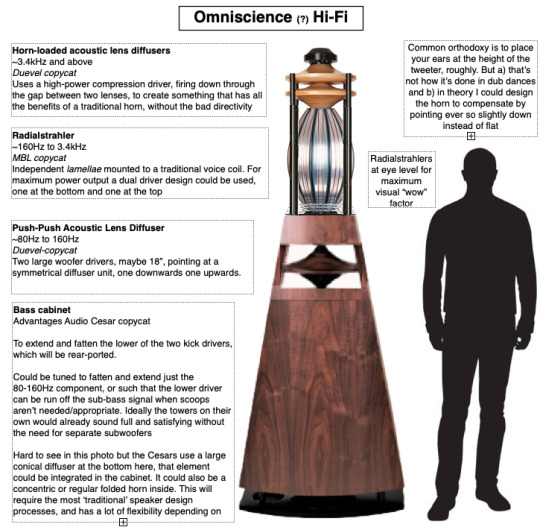


As for order of operations:
Step 1:
Make a cheap and cheerful prototype of the MBL drivers. I just want to cut my teeth on the hardest part, to start building familiarity with the materials, principles, and manufacturing processes that will be involved in the build of the larger, final version.
If my friend who's into CAD and CNCing is willing, have him whip up some test lenses.
Use recycled drivers from old, cheap speakers as much as I can to keep initial exploratory costs down.
Find an active cossover unit that I can use to test different crossover frequencies with the different driver designs
Step 1 will be considered finished when I either have a working, not-awful-sounding radialstrahler, or have decided to abandon that aspect and am comfortable focusing on other methods for making omnidirectional sound.
Step 2:
Work on the other parts of the tower, namely the horn-loaded lens tweeter, the mid-bass lens, and the lower cabinet (lots of flexibility for internal design with the cabinet).
The cabinet (and maybe the horn lenses) will require learning to use a speaker simulation software
The bass scoops can come later, as there's not a lot of point building small/low-power scoops
As soon as I have a sense of what the appropriate crossover frequencies will be, order a custom dub preamp such as the RasFX Mini Pre
Get a set of relatively affordable power amps to drive the whole thing. 4 channels for a single tower to start with
Step 2 will be considered complete when I can gift (for cost of materials) a MK1 pair of these speakers to a friend of mine who's into sound system too - and of course build a set for myself!
Step 3:
Assuming everything goes smoothly in Step 2, work on scaling everything up. Size, power levels, etc. The rough goal is to be able to power a party with around 100-200 people. Maybe more, eventually
Try to figure out a way to be able to retain the functionality of a dub preamp for playing reggae, but also run the system in stereo for when I want to play
Build a set of scoop style subwoofers. The more, the bigger, the better!
Step 3, and thus the main body of the project will be considered complete when I have a fully functional, high-power sound system able to at least impress, though maybe not directly 'compete with', the current generation of younger sound systems like Indica Dubs, Ital Power, Creation Rebel, King Majesty, Sinai, and other such outfits.
-------------------
Step 4:
If everything up until this point has gone very well, and I feel confident with the various technologies, try to develop the designs to a point where it can stand as a single 'totem pole' style tower that can play to a decently-sized crowd of people.
I picture taking something like that to e.g. Boomtown Festival, and decorating it in all sorts of wacky space-age or mystical art. I think the fung shui of a single, central sound source would be really unique in a festival setting.
The big barrier is that omnis, when places inside, rely on walls and surfaces to create the feeling of 'omnipresence'. Outside, I'm not sure that'd work at all, let alone
Step 4 being complete would inherently require my sound to be powerful enough, high-enough-fidelity, and well-known enough to be included when people talk about "well-established" sound systems. The totem pole thing is a bit of a gimmick, let's be honest.
------------------
Imaginary step 5: If my work on this project can inspire more people to think outside the proverbial speakerbox when it comes to building reggae sound systems, I'd be a happy camper!
#sound system#reggae#dub#preamp#amplifier#jah shaka#Steppas#UK dub#UK Steppas#omnidirectional#omnidirectional speakers#Experimental audio#DIY audio#DIY speakers#MBL Radialstrahlers#Duevel#Hifi#Stereo#Audio engineering#acoustics#Totem Pole#Speaker Design#DIY Speaker#MBL Xtreme#MBL 101#MBL#Channel one Sound System#Jah Shaka Sound System#Aba Shanti#Aba Shanti Sound System
2 notes
·
View notes
Text
How to Choose the Right Omnidirectional Speakers for Your PA System
When it comes to creating an immersive and captivating audio experience, choosing the right speakers for your PA system is crucial. Omnidirectional speakers are a popular choice due to their ability to distribute sound uniformly in all directions, ensuring that every corner of the venue receives clear and consistent audio.
To select the perfect omnidirectional speakers for your PA system, there are several factors to consider. Firstly, assess the size of the venue and the number of attendees. Larger spaces require speakers with higher power output to ensure adequate sound coverage without distortion. Conversely, smaller venues can benefit from compact yet powerful speakers.
Next, consider the frequency response of the speakers. Look for a wide frequency range that can handle both low and high tones effectively. This will result in a balanced sound that appeals to all listeners. Additionally, pay attention to the speaker's sensitivity, as higher sensitivity ratings can deliver louder sound with lower power input.
Furthermore, take note of the build quality and durability of the speakers. Opt for models constructed from robust materials that can withstand the rigors of frequent transportation and use. Weather-resistant features are also vital for outdoor events.
For a seamless integration into your existing PA system, check the compatibility options of the speakers. Whether you're using them as standalone units or as part of a larger setup, ensuring they work harmoniously with other equipment is essential.
Finally, explore reputable brands and trusted suppliers to ensure you are investing in high-qualityPA speakers. One such trusted source is www.owi-inc.com, which offers a wide range of professional audio equipment, including top-notch omnidirectional speakers. By considering these factors and sourcing your omnidirectional speakers from reliable suppliers like OWI Inc., you can elevate your PA system to new heights, providing an exceptional audio experience that will leave your audience captivated and delighted.
0 notes
Text
German Physics Omnidirectional Speaker Open Day - 27th April!
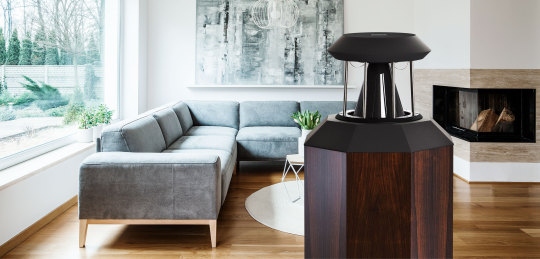
Hi Everyone,
It's time for our first Open day of 2024 and this one is something a little different as it is for a speaker brand we do that I have always loved but I'm sure a lot of people have actually never sat down and listened to, German Physics, who are the world leaders in Omnidirectional Loudspeakers giving a very different presentation to a conventional speaker. For those who don't know what an Omnidirectional speaker is, basically they present the music in 360 degrees. Not only are they very musical but be being an Omnidirectional design they give a huge soundstage recreating that music hall live sound, they really are quite special and well worth a listen so if you are around on April 27th please do come in for a listen.
We will have both of our 2 downstairs demo rooms running, the first room with have the £19,500 HRS-130 speakers in and the next room will have the next model up, the Borderland MK IV playing, this was German Physics first speaker back in 1992 and is their most popular speaker.
Designed and manufactured in Germany the full range of German Physics loudspeakers embody the same DDD driver which eliminates the crossover point in the very important mid-range. The DDD driver also has a wide frequency range typically, from 200Hz to 24Khz and is phase linear across this bandwidth. All frequencies in its operating range radiate evenly through 360 degrees around the loudspeaker in a horizontal plane producing a stereo image you can enjoy from a wide range of positions in the listening room.
Over the years Omnidirectional loudspeakers have gone from a curiosity that few people were aware of and even fewer had heard to a class of loudspeakers that you will find at almost any audio show and offer a different approach to the traditional speaker design so for something truly different please feel free to join us.
Please find a very enthusiastic review from Terry Ellis below, as you can see he was extremely impressed, these are the actual speakers we will have at our open day much to Terry's disappointment as he would have loved to have kept them longer.
youtube
HiFi+ Editors Choice Award for Borderland MK IV's
Over the years German Physics have won countless awards and the latest addition to these is from HiFi+ who have just awarded the Borderland MK IV's their Editors Choice award, please see below -

RSVP Please!
We will have food and drink available on the day as well as representatives along from German Physics to help run the day and answer any questions you may have.
It would be great if you'd like to come along to experience something a little different, I think you will be very surprised just how good these speakers sound, if you can make it along can you please fire me a quick mail to the below, thanks -
Please also find a link below to the full German Physics range of speakers on our website below and a few pictures -
Hope to see you on April 27th,
All the best,
Regards,
Paul.
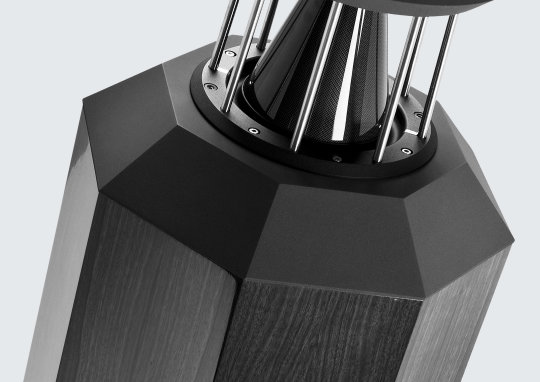


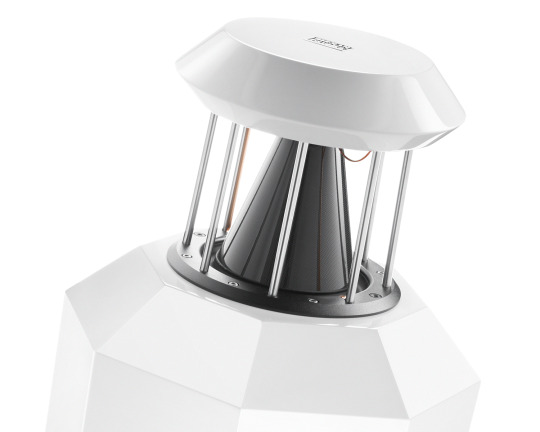





1 note
·
View note
Link
Check out this listing I just added to my Poshmark closet: LG XBOOM 360 RP4BE Omnidirectional Portable Speaker.
0 notes
Text
Avantgarde Acoustic UNO SD Hornspeaker $48,800 Review
https://www.enjoythemusic.com/superioraudio/equipment/0324/Avantgarde_Acoustic_UNO_SD_Hornspeakers_Review.htm
I’ve been reviewing high-end audio equipment for over 35 years and have been fortunate enough to hear many different types of speakers – large, small, dynamic, electrostatic, horned, bi-directional, omnidirectional… you name it. One of the luckiest I’ve ever felt was when reviewing the…

View On WordPress
1 note
·
View note
Text
Week 7 - Theory - Miking guitar amps
There are many different factors which can affect a guitar amp recording.
Type of guitar amp
Different amps can vary in different ways - some have multiple speakers, which could be worth miking up separately.
Choice of microphone
Typically when recording a guitar amp, a condenser microphone is used with an omnidirectional polar pattern.
Ribbon mics are popular when recording harsher instruments, however they tend to be placed slightly further from the speaker grille, approximately a few inches, as they have a pronounced proximity effect when compared to condensers.
Room characteristics + amp position
An ambient room microphone could be a suitable choice, but only if the sound of the room itself is good.
Another thing to consider is the position of the amp in the room - raising the amp will factor in more of the room sound, which could be advantageous. Additionally, an amp on carpet will give a different sound to an amp on a wooden floor.
Distance between mic & cab
A microphone directly against the cab will solely give the output of the speaker. Moving it back approximately 30cm allows more of the environment to filter into the sound, and further distances allow the reflections of the speaker to develop and add texture to the sound.
Miking the speaker cone
When miking the speaker cone, the tone of the sound will change depending on where along the cone you record. The centre of the cone emphasises midrange and upper-mid frequencies, whether the edge reduces these. Recording between these can provide a middle ground between the two.
On-axis v. off-axis
In on-axis recording, the microphone is perpendicular to the front of the cab. This tends to sound brighter, however has a greater chance to cause the proximity effect.
Off-axis angles the mic to the side, which causes some roll-off of high end frequencies however reduces proximity effect, and in some cases can sound warmer. One problem with this is that it may bring in greater unwanted reflections.

Using multiple mics
When using multiple microphones, choose the first based on the tone that you're trying to achieve. Then, choose a second mic that will fill whatever is missing from the first mic.
For amps with multiple speakers, placing a microphone on each may give you more options tonally.
If available, a microphone positioned further from the amp can provide a nice ambience which pairs nicely with the dry sound from the closer mis.
Adding a rear mic
In some cases, placing a mic inside the cabinet at the back can help to recreate the sound of the room itself. If this is done, this microphone should always be out of phase with those at the front.
References:
https://www.audiotechnology.com/tutorials/microphones-polar-responses-1
0 notes